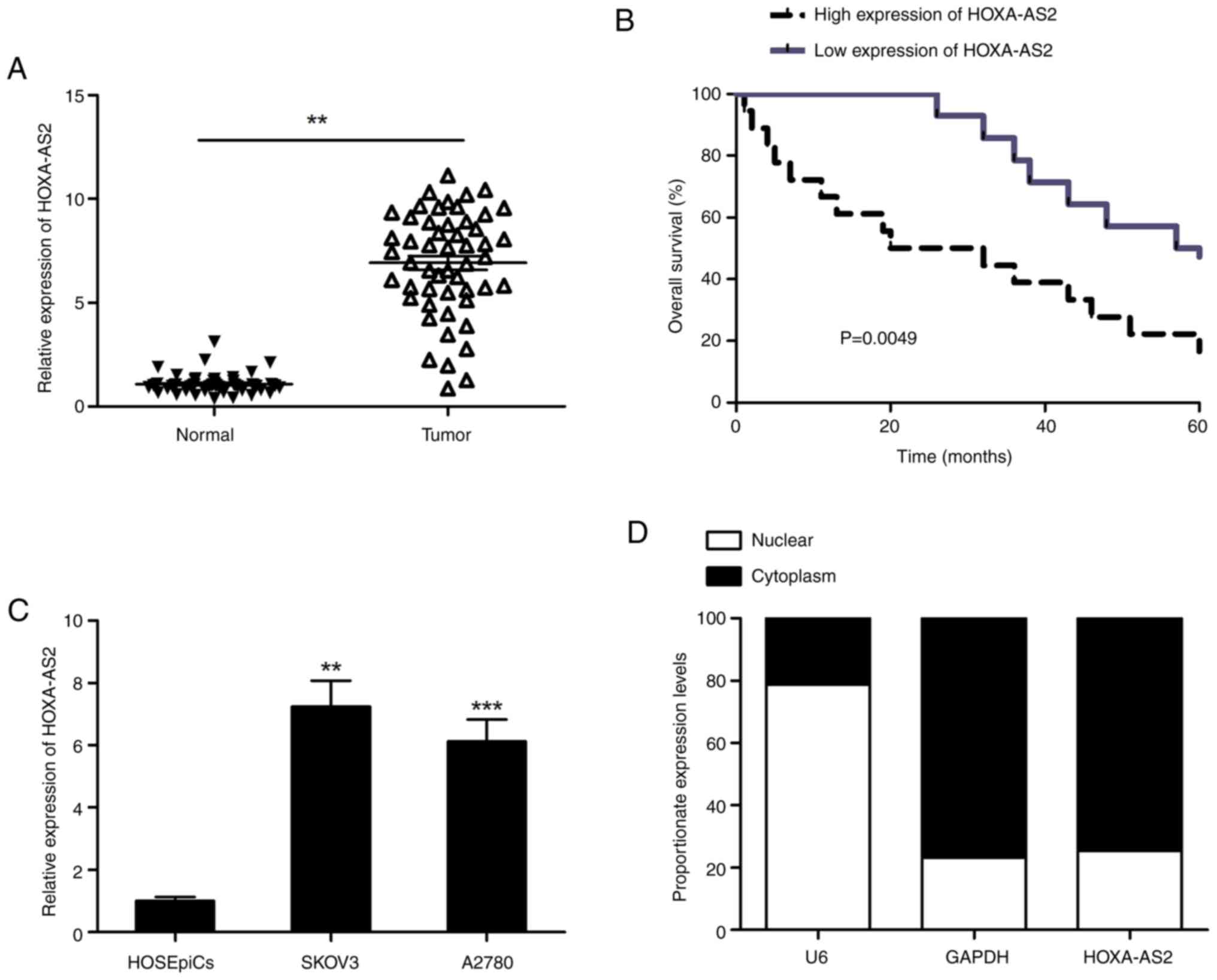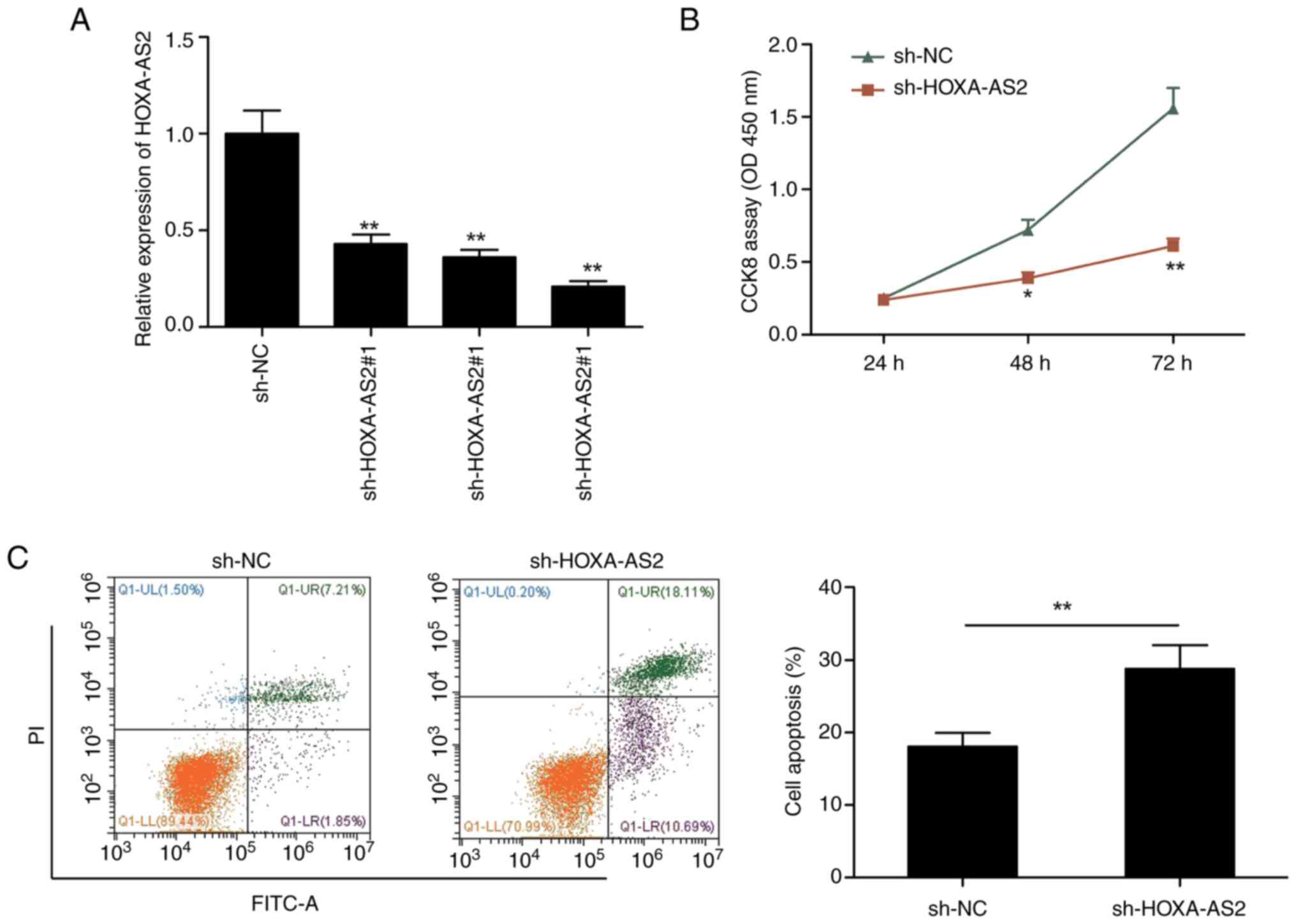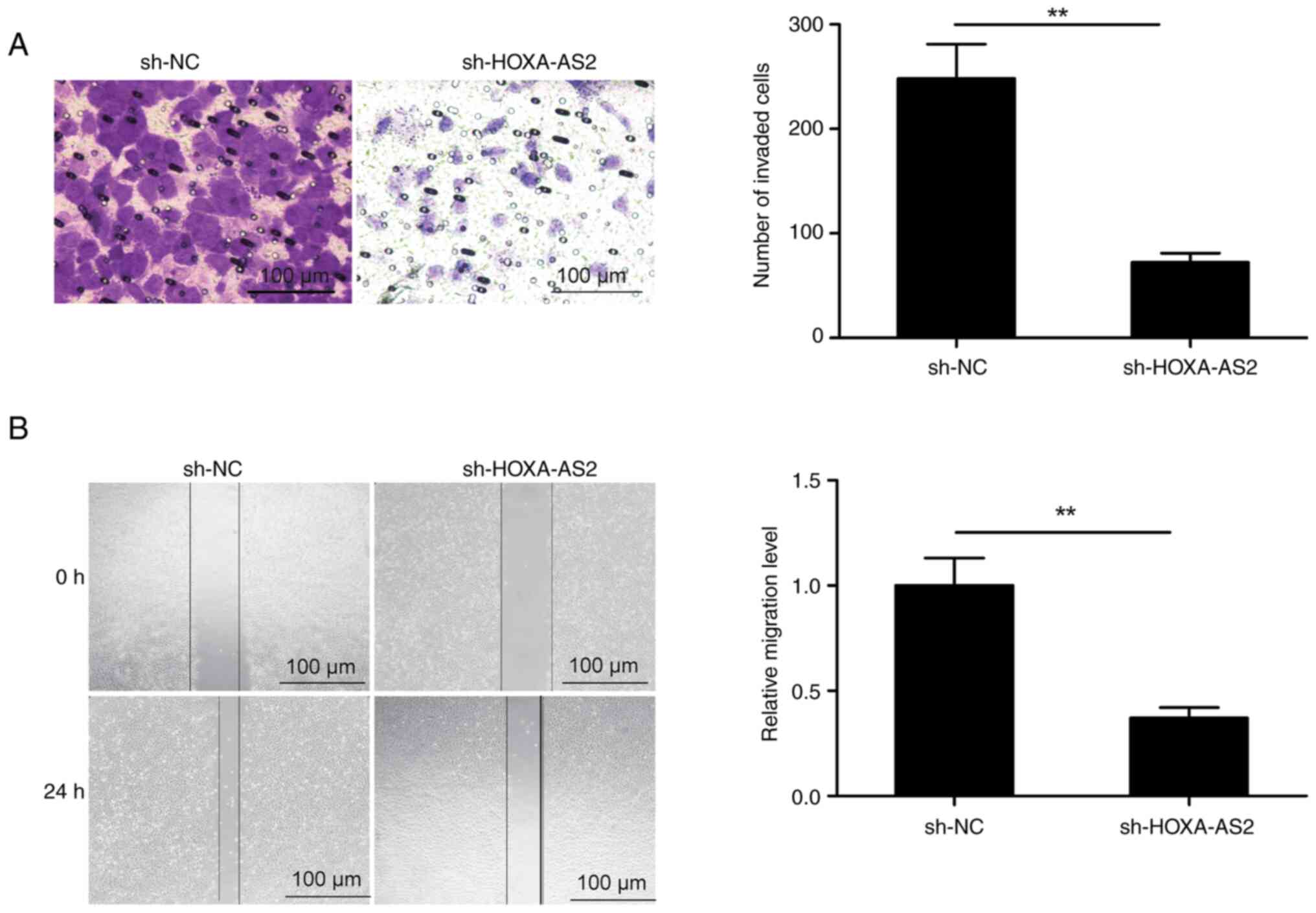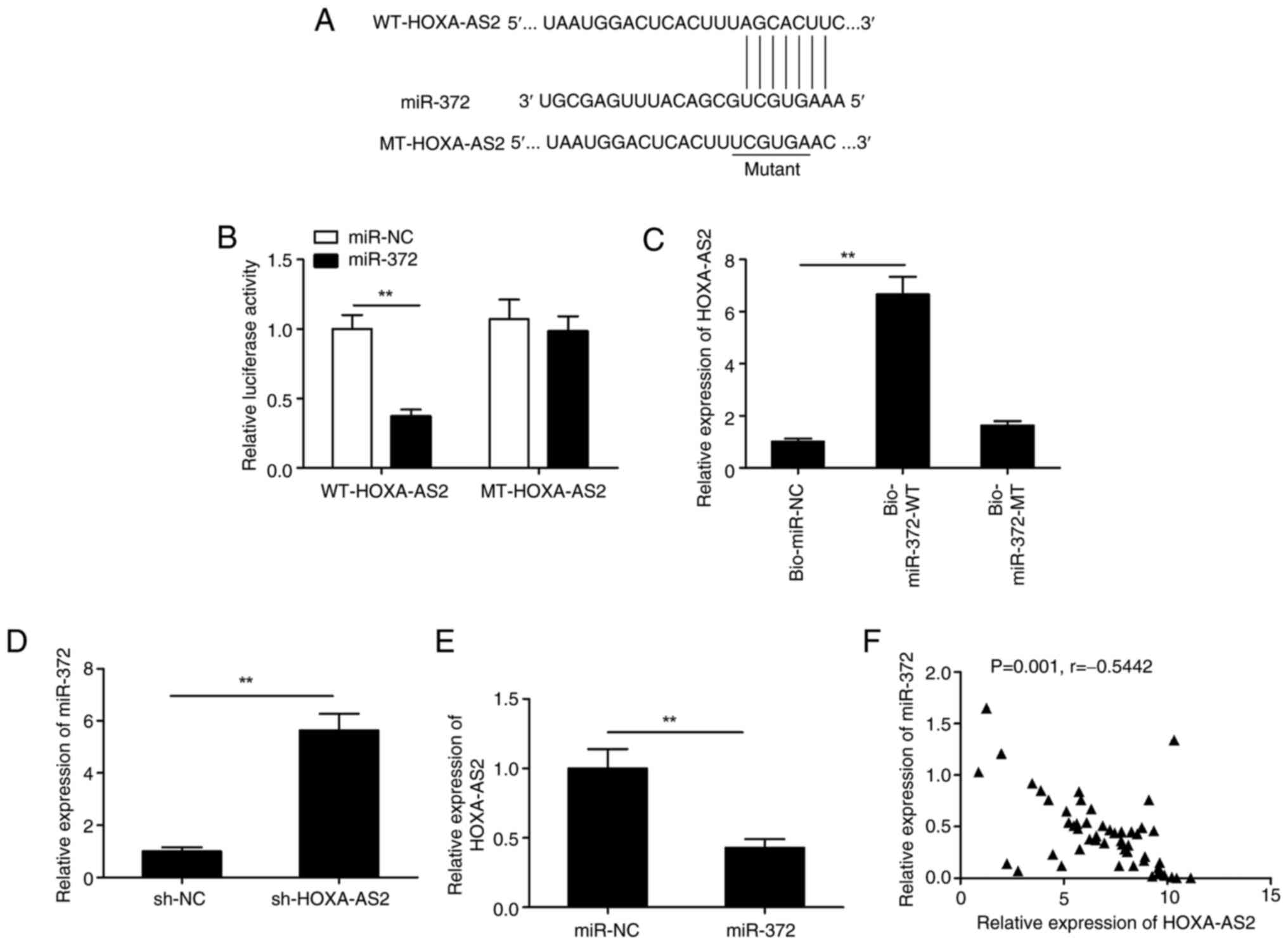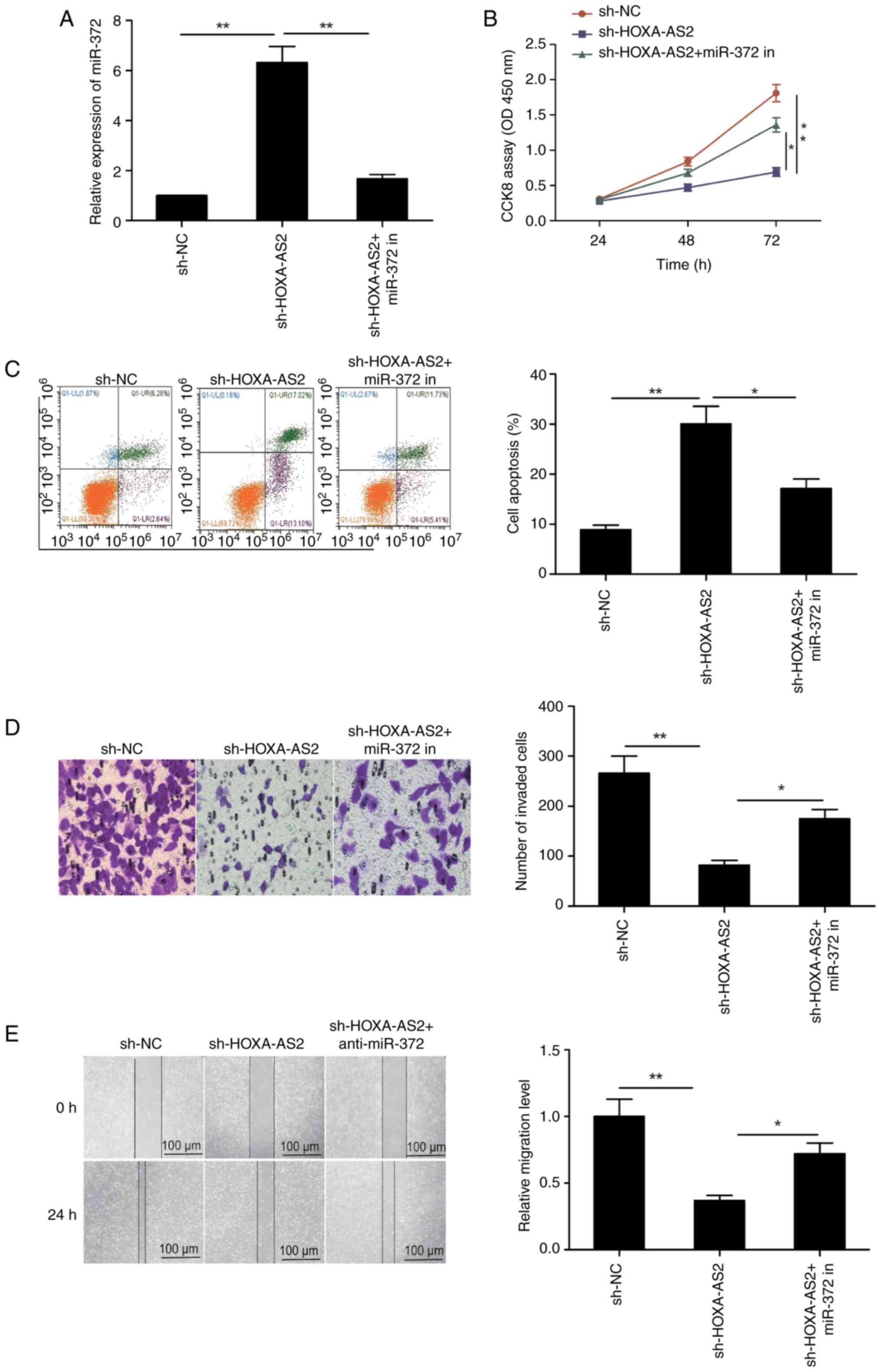LncRNA HOXA‑AS2 promotes the progression of epithelial ovarian cancer via the regulation of miR‑372
- Authors:
- Published online on: June 25, 2024 https://doi.org/10.3892/ol.2024.14527
- Article Number: 394
-
Copyright: © Wang et al. This is an open access article distributed under the terms of Creative Commons Attribution License.
Abstract
Introduction
Despite advancements in treatment, the prognosis of patients with epithelial ovarian cancer (EOC), an aggressive malignant form of cancer, is poor; which may be attributed to the combined effect of metastasis and multidrug resistance (1–3). The development of understanding of the underlying mechanism of tumor growth and development in EOC is important to identify new diagnostic markers and therapeutic targets.
Non-coding RNAs (ncRNAs) including microRNAs (miRNAs/miRs) and long non-coding RNAs (lncRNAs), do not have protein-coding potential, and serve vital roles in the regulation of cellular processes, such as cellular growth, differentiation and apoptosis (4–6). Previous studies have reported that miRNAs and lncRNAs serve crucial roles in tumorigenesis in certain types of cancer including lung cancer (7) and liver cancer (8) and can function as oncogenes or tumor suppressor genes (7,8). Certain miRNAs and lncRNAs have also been reported to be involved in tumor development in EOC (9,10).
One such lncRNA, HOXA-AS2, is located between the homeobox protein Hox-A3 and homeobox protein Hox-A4 genes in the homeobox A (HOXA) cluster, and has been reported to promote tumor progression in prostate cancer (11), bladder cancer (12), papillary thyroid cancer (13), colorectal cancer (14), breast cancer (15), hepatocellular carcinoma (16) and pancreatic cancer (17). However, the expression status, cellular function and molecular mechanism underlying the role of HOXA-AS2 in the progression of EOC remains unclear. In the present study, the role of HOXA-AS2 in the development of EOC was assessed by a series of molecular and cellular biology methods.
Materials and methods
Tissue samples
EOC tissue samples were collected from patients who had undergone curative surgical treatment between March 2013 and March 2014 at the First Hospital of Jilin University (Changchun, China). All patients provided written informed consent for participation in the present study. Paired cancerous and noncancerous tissues (2 cm from the EOC tissues; n=52) were collected and stored in liquid nitrogen until further use. Two pathologists independently confirmed the EOC diagnosis. None of the enrolled patients had received any perioperative treatment, such as radio-chemotherapy. The clinicopathologic data of the patients with EOC that participated in the present study are presented (Table I). The present study was compliant with the Declaration of Helsinki and was approved by the Ethics Committee of the First Hospital of the Jilin University (Jlu20210121-1; Changchun, China).
Table I.Association of HOXA-AS2 expression with clinicopathologic factors of patients with epithelial ovarian cancer. |
Cell culture and transfection
The human EOC SKOV3 and A2780 cell lines, and human ovarian surface epithelial cells (HOSEpiCs) were purchased from the American Type Culture Collection and were grown in RPMI-1640 medium containing 10% fetal bovine serum (FBS; Gibco; Thermo Fisher Scientific, Inc.) in a 5% CO2 incubator at 37°C.
Lentivirus-mediated HOXA-AS2 short hairpin RNAs (sh-HOXA-AS2s) and a non-targeting control shRNA (sh-NC) were constructed and packaged by Guangzhou Geneseed Biotech. Co., Ltd. with sequences as follows: sh-HOXA-AS2#1, 5′-GCTTACCTAGAAAGATGTTTCAAGAGAACATCTTTCTAGGTAAGCG-3′; sh-HOXA-AS2#2, 5′-TTTGCGTCTACAGACCTATCTTCAAGAGAGATAGGTCTGTAGACGCAAAG-3′; sh-HOXA-AS2#3, 5′-AGTTCAGCTCAAGTTGAACATTCAAGAGATGTTCAACTTGAGCTGAACTC-3′; and sh-NC, 5′-TTCTCCGAACGTGTCACGTCAAGAGATTACGTGACACGTTCGGAGAA-3′.
SKOV3 cells were plated in 6-well plates and grown to a cell density of ~60%, and then transfected with sh-HOXA-AS2 or sh-NC using Lipofectamine® 2000 (Invitrogen; Thermo Fisher Scientific, Inc.) according to the manufacturer's instructions.miR-372-3p inhibitor (anti-miR; 5′-GCUCAAAUGUCGCAGCACUUUUU-3′), inhibitor-negative control (anti-miR-NC; 5′-UUCUCCGAACGUGUCACGUTT-3′), miR-372-3p mimic (5′-AAAGUGCUGCGACAUUUGAGCGUGCUCAAAUGUCGCAGCACUUUUU-3′) and miR-NC (5′-ACGUGACACGUUCGGAGAATT-3′) were purchased from MedChemExpress. Transfection, of 100 nM miR-372 mimics, miR-NC, anti-miR-372 and anti-miR-NC into SKOV3 cells using Lipofectamine® 2000 (Invitrogen; Thermo Fisher Scientific, Inc.) was performed according to the manufacturer's protocol. Transfection efficiency was examined after 48 h using reverse transcription-quantitative PCR (RT-qPCR).
RT-qPCR
RNA was extracted from EOC samples using TRIzol reagent (Invitrogen; Thermo Fisher Scientific, Inc.) and reverse transcribed using the PrimeScript RT reagent kit (Takara Bio, Inc.) at 25°C for 10 min, 50°C for 45 min and 85°C for 5 min. Complimentary DNA was quantified using an ABI 7900 qPCR System with SYBR Green Real-time PCR Master Mix (Takara Bio, Inc.). The thermocycling conditions used were as follows: Denaturation at 94°C for 3 min, followed by 40 cycles of denaturation at 94°C for 15 sec, annealing at 60°C for 30 sec and extension at 72°C for 30 sec. All experiments were performed using previously described primers (14,18). The primers used were as follows: miR-372 forward (F), 5′-ACACTCCAGCTGGGAAAGTGCTGCGACATTT-3′ and reverse (R), 5′-GTGCAGGGTCCGAGGT-3′; HOXA-AS2 F, 5′-CCCGTAGGAAGAACCGATGA-3′ and R, 5′-TTTAGGCCTTCGCAGACAGC-3′; U6 F, 5′-CTCGCTTCGGCAGCACATATACT-3′ and R, 5′-ACGCTTCACGAATTTGCGTGTC-3′; and GAPDH F, 5′-GGGAAACTGTGGCGTGAT-3′ and R, 5′-GAGTGGGTGTCGCTGTTGA-3′. Relative gene expression levels were calculated from the data of three independent experiments using the 2–∆∆Cq method (19). U6 was used as the internal reference for miR-372 and GAPDH was used as the internal reference for HOXA-AS2.
Subcellular fractionation
A PARIS Kit (Thermo Fisher Scientific, Inc.) was used to separate the nuclear and cytoplasmic fractions of SKOV3 cells according to the manufacturer's protocols. RT-qPCR was then used to assess HOXA-AS2 expression in these fractions, with U6 serving as a nuclear control and GAPDH as a cytoplasmic control, according to the aforementioned method.
Cell proliferation assay
Transfected EOC cells (5×103 cells/well) were seeded and incubated in a 96-well plate for up to 72 h, with samples being isolated at 3 time points (24, 48 and 72 h) followed by the addition of CCK-8 solution (10 µl/well, Takara Bio, Inc.) for 28 h. A spectrophotometer (BioTek Instruments; Agilent Technologies, Inc.) was then used to measure the absorbance at 450 nm for each time point.
Cell apoptosis assay
The apoptosis of HOXA-AS2-depleted SKOV3 cells was assessed using Annexin V-FITC/PI apoptosis detection kits (cat. no. A211; Vazyme Biotech Co., Ltd.) for fluorescence activated cell sorting on a BD FACSCanto™ II flow cytometer (BD Biosciences) according to the manufacturer's protocols. The apoptotic rate was calculated and analyzed using FlowJo 6.10 (FlowJo LLC).
Cell invasion assay
A Transwell invasion plate with a pore size of 8 mm, which was precoated with Matrigel was used to investigate the invasion ability of SKOV3 cells. Briefly, the transfected cells (5×104 cells/well) were added to the top chamber of the Transwell plate in serum-free medium, while the bottom chamber was filled with RPMI1640 medium containing 20% FBS (Gibco; Thermo Fisher Scientific, Inc.). After 24 h, the cells fixed with 4% paraformaldehyde at 25°C for 30 min and stained with 0.1% crystal violet (Sigma-Aldrich; Merck KGaA) at 25°C for 10 min. Cells were imaged and counted in five different fields of view using an X71 inverted light microscope (Olympus Corporation).
Wound healing assay
The transfected cells (5×104 cells/well) were seeded and cultured in a 6-well plate until confluent. The monolayer was then scratched with a pipette tip and cultured in a serum-free medium for 24 h. Baseline (0 h) and 24 h images were acquired using an X71 inverted light microscope (Olympus Corporation). Migration rate was calculated by dividing the change in wound width by the time spent in migration as previously described by Grada et al (20). ImageJ software (V1.8.0; National Institutes of Health) was used to measure the size of the wound.
Bioinformatics and luciferase reporter assays
The ENCORI database (http://starbase.sysu.edu.cn) was used to analyze the HOXA-AS2 binding interaction with miRNAs. Among the miRNAs identified, miR-372, which is known to serve tumor-suppressive roles in several cancers (18,21,22), was selected for further study. Wild-type and mutant HOXA-AS2 fragments with/without the binding sites for miR-372 were synthesized and placed into the psiCHECK2 vector (Promega Corporation) and were referred to as WT-HOXA-AS2 or MT-HOXA-AS2, respectively. The SKOV3 cells were cultured in a 12-well plate util ~80% confluent. Then, cells were co-transfected with a luciferase plasmid and either miR-372 mimics or miR-NC using Lipofectamine® 2000 (Invitrogen; Thermo Fisher Scientific, Inc.). After 24 h, activity was measured using a Dual-Luciferase Reporter Assay System (Promega Corporation). Firefly luciferase activity was normalized to Renilla luciferase activity.
Biotinylated RNA pull-down assay
Biotinylated derivatives of wild-type, mutant or control miR-372 (Bio-miR-372-WT, Bio-miR-372-MT or Bio-NC, respectively) were purchased from Guangzhou RiboBio Co., Ltd. The biotinylated RNA was transfected into SKOV3 cells using Lipofectamine® 2000 and cultured at 37°C with 5% CO2 for 48 h based on the manufacturer's instructions. SKOV3 cells (1×107) were lysed in the soft lysis buffer plus 80 U/ml RNasin (Promega Corporation). The cell lysate (100 µl) was then precipitated with M-280 streptavidin beads (Sigma-Aldrich; Merck KGaA) at 4°C for 12 h. The beads were harvested by centrifugation at 13,000 × g for 10 min at 4°C. The bound RNAs were purified using the RNeasy Mini kit (Qiagen GmbH). HOXA-AS2 expression was assessed in the purified RNA using RT-qPCR performed to the aforementioned method
Statistical analyses
SPSS v19.0 (IBM Corp.) was used to analyze data, which was presented as the mean ± SD. The χ2 test was used to assess the relationship between HOXA-AS2 expression and the clinicopathologic features of patients with EOC. An unpaired Student's t-test (two-tailed) or ANOVA followed by Bonferroni's post hoc test were used to assess the statistical significance of differences. Kaplan-Meier analysis, coupled with the log-rank test, was performed to investigate the overall survival rate. Pearson's correlation coefficient was used to assess the correlation between HOXA-AS2 and miR-372. P<0.05 was considered to indicate a statistically significant difference.
Results
Elevated HOXA-AS2 in EOC samples is correlated with poor prognosis
Expression levels of HOXA-AS2 in the EOC tissues were significantly higher compared with those in the noncancerous tissues (Fig. 1A). All 52 patients with EOC were classified into two groups based on the mean expression level of HOXA-AS2, a high expression level (n=27) and a low expression level (n=25) group, to assess the relationship between levels of HOXA-AS2 and clinicopathological features. There was no significant association between the levels of HOXA-AS2 and, age or tumor size in the patients with EOC; however, a significant association was demonstrated between the expression level of HOXA-AS2 and lymph node metastasis and advanced Federation International of Gynecology and Obstetrics (FIGO) stage (Table I). Furthermore, Kaplan-Meier analysis demonstrated that elevated levels of HOXA-AS2 was associated with reduced overall survival in patients with EOC (Fig. 1B). Moreover, both EOC cell lines demonstrated significantly higher HOXA-AS2 expression levels compared with HOSEpiCs (Fig. 1C). The SKOV3 cell line showed a notably higher HOXA-AS2 expression level compared with the A2780 cell line, and was used in subsequent experiments. The localization of HOXA-AS2 in SKOV3 cells was assessed, which indicated that HOXA-AS2 was mainly located in the cytoplasm of SKOV3 cells (Fig. 1D).
HOXA-AS2 knockdown inhibits EOC cell proliferation and induces apoptosis
To evaluate the biological role of HOXA-AS2, three lentivirus-mediated HOXA-AS2 shRNAs (sh-HOXA-AS2#1, sh-HOXA-AS2#2 and sh-HOXA-AS2#3) and a sh-NC were transfected into SKOV3 cells. Compared with sh-NC, all three shRNAs significantly reduced the expression of HOXA-AS2 in SKOV3 (Fig. 2A). sh-HOXA-AS2#3 showed the maximum reduction and was used in all subsequent experiments, where it was labeled as sh-HOXA-AS2. Furthermore, the CCK-8 assay indicated that the knockdown of HOXA-AS2 significantly decreased SKOV3 cells proliferation (Fig. 2B) and significantly induced cell apoptosis (Fig. 2C) compared with the sh-NC.
The migration and invasion of the EOC cells is suppressed by the knockdown of HOXA-AS2
Transwell and wound healing assays were performed to assess the effect of the knockdown of HOXA-AS2 on the invasion and migration of SKOV3 cells. The results demonstrated that knockdown of HOXA-AS2 significantly decreased both cell invasion and migration in SKOV3 cells compared with the control (Fig. 3).
HOXA-AS2 functions as a competing endogenous RNA (ceRNA) which directly interacts with miR-372 in EOC cells
It has been previously reported that lncRNAs can regulate specific miRNAs involved in carcinogenesis by functioning as ceRNAs (23,24). The ENCORI database was used to predict the miR-372-HOXA-AS2 interaction. The results indicated that miR-372 contained a complementary binding sequence to HOXA-AS2 and thus, this was the potential target of HOXA-AS2 (Fig. 4A). This hypothesis was tested using a luciferase activity assay. Overexpression of miR-372 significantly reduced the luciferase activity of WT-HOXA-AS2 exclusively, with no significant difference demonstrated in MT-HOXA-AS2 (Fig. 4B). Moreover, the biotinylated RNA pull-down assay demonstrated that the bio-miR-372-WT group had significantly higher levels of HOXA-AS2 compared with both the control (bio-NC) and bio-miR-372-MT groups (Fig. 4C). HOXA-AS2 knockdown significantly increased the expression of miR-372 in SKOV3 cells compared with the negative control (Fig. 4D). However, a significant reduction in the expression of HOXA-AS2 was caused by the overexpression of miR-372 (Fig. 4E). There was a significant negative correlation between miR-372 expression and HOXA-AS2 in EOC tissues (P=0.001; r=−0.5442; Fig. 4F). This indicated that there was a direct interaction between HOXA-AS2 and miR-372, and thus that miR-372 functioned as a ceRNA.
Knockdown of HOXA-AS2 inhibits the progression of EOC through the sponging of miR-372
Since HOXA-AS2 functions as a ceRNA by sponging miR-372, it was hypothesized that HOXA-AS2 might affect the progression of EOC by regulating miR-372. Rescue experiments in SKOV3 cells demonstrated that the knockdown of HOXA-AS2 significantly increased the levels of miR-372 in SKOV3 cells, while transfection with the miR-372 inhibitor significantly reversed this effect (Fig. 5A). Furthermore, downregulation of miR-372 significantly reversed the inhibitory effects of HOXA-AS2 depletion on cellular proliferation, apoptosis, invasion and migration in SKOV3 cells (Fig. 5B-E). Thus, HOXA-AS2 depletion inhibited the progression of EOC through the regulation of miR-372.
Discussion
LncRNAs function as oncogenic genes in tumor development and are used as diagnostic markers for EOC (9,10). Wang et al (25) reported that the lncRNA TP73-AS1 promoted EOC cell proliferation and metastasis via regulation of MMP2 and MMP9. Similarly, Fang and Xia (26) reported that the interaction between lncRNA HLA-F-AS1 and the miR-21-3p/PEG3 axis promoted cellular growth in EOC, both in vitro and in vivo. Another study reported that SNHG17 promoted EOC proliferation and metastasis by regulating the transcription of Forkhead box A1 (27). In the present study, it was demonstrated that compared with noncancerous tissues and HOSEpiCs, HOXA-AS2 levels were upregulated in EOC tissues and cell lines, and that HOX-AS2 levels were associated with advanced FIGO grade and poor prognosis. It was also demonstrated that HOXA-AS2 served a tumorigenic role in EOC development through sponging of miR-372.
The association between abnormal expression of HOXA-AS2 and carcinogenesis has been extensively studied (11–17). However, the biological role, especially in migration and invasion, and regulatory mechanism of HOXA-AS2 in EOC remain unclear. To the best of our knowledge, the present study is the first to identify upregulated expression of HOXA-AS2 in EOC samples, which was linked to its poor prognosis. Moreover, a loss-of-function assay demonstrated that knockdown of HOXA-AS2-resulted in a decrease in EOC proliferation and invasion, which indicated that HOXA-AS2 promoted the progression of EOC. LncRNAs are known to exert their biology role through the ceRNA mechanism by acting as a ‘sponge’ for miRNAs, to regulate their expression and function (23,24). The role of miRNAs has been reported in the tumorigenesis and progression of numerous cancers, where they function as oncogenes and tumor suppressors (28,29). Numerous miRNAs have been reported to serve key roles in the initiation and development of EOC, and might act as novel therapeutic targets and clinical biomarkers for EOC (30,31). HOXA-AS2 acts via the ceRNA mechanism for certain types of miRNAs, including miR-855-5p (11), miR-509-3p (32), miR-125b (12), miR-15a-3p (13), miR-106a (15) and miR-520c-3p (16). In EOC, miR-372 has been reported to be downregulated and to function as a tumor suppressor (18). The luciferase reporter assay, RT-qPCR, and RNA pull-down assays confirmed the binding of miR-372 and HOXA-AS2 in EOC cells. Moreover, there was a negative correlation between miR-372 levels and HOXA-AS2 in samples from patients with EOC. Downregulation of HOXA-AS2 mediated the inhibition of cell growth which was effectively reversed by the inhibition of miR-372. These results indicated that HOXA-AS2 acted as an endogenous sponge RNA to inhibit the action of miR-372 in human EOC cells.
There are two main limitations in the present study. First, at least one additional cell line should have been used to assess HOXA-AS2 function in EOC. Second, the molecular mechanism of HOXA-AS2 in EOC require further investigation
In conclusion, the present study demonstrated that elevated levels of HOXA-AS2 in EOC tissues and cell lines was associated with poor prognosis. Mechanistically, HOXA-AS2 facilitated cellular growth in the SKOV3 cells by regulating miR-372. Further experiments using different EOC cell lines are required to examine the efficiency of HOXA-AS2 as a novel therapeutic target for EOC.
Acknowledgements
Not applicable.
Funding
This work was supported by the Program of Science and Technology Development Plan of Jilin Province (grant no. 20200201466JC).
Availability of data and materials
The data generated in the present study may be requested from the corresponding author.
Authors' contributions
WS conceived the study. YW performed the experiments and wrote the manuscript. WS analyzed the data. WS and YW confirm the authenticity of all the raw data. Both authors read and approved the final manuscript.
Ethics approval and consent to participate
The present study was approved by the Ethics Committee of the First Hospital of the Jilin University (approval no. Jlu20210121-1; Changchun, China) and was in accordance with the Declaration of Helsinki.
Patient consent for publication
Not applicable.
Competing interests
The authors declare that they have no competing interests.
References
|
Sambasivan S: Epithelial ovarian cancer: Review article. Cancer Treat Res Commun. 33:1006292022. View Article : Google Scholar : PubMed/NCBI | |
|
Lheureux S, Braunstein M and Oza AM: Epithelial ovarian cancer: Evolution of management in the era of precision medicine. CA Cancer J Clin. 69:280–304. 2019. View Article : Google Scholar : PubMed/NCBI | |
|
Nougaret S, McCague C, Tibermacine H, Vargas HA, Rizzo S and Sala E: Radiomics and radiogenomics in ovarian cancer: A literature review. Abdom Radiol (NY). 46:2308–2322. 2021. View Article : Google Scholar : PubMed/NCBI | |
|
Wang X, Arai S, Song X, Reichart D, Du K, Pascual G, Tempst P, Rosenfeld MG, Glass CK and Kurokawa R: Induced ncRNAs allosterically modify RNA-binding proteins in cis to inhibit transcription. Nature. 454:126–130. 2008. View Article : Google Scholar : PubMed/NCBI | |
|
Cech TR and Steitz JA: The noncoding RNA revolution-trashing old rules to forge new ones. Cell. 157:77–94. 2014. View Article : Google Scholar : PubMed/NCBI | |
|
Ponting CP, Oliver PL and Reik W: Evolution and functions of long noncoding RNAs. Cell. 136:629–641. 2009. View Article : Google Scholar : PubMed/NCBI | |
|
Sun T: Long noncoding RNAs act as regulators of autophagy in cancer. Pharmacol Res. 129:151–155. 2018. View Article : Google Scholar : PubMed/NCBI | |
|
Huarte M: The emerging role of lncRNAs in cancer. Nat Med. 21:1253–1261. 2015. View Article : Google Scholar : PubMed/NCBI | |
|
Braga EA, Fridman MV, Moscovtsev AA, Filippova EA, Dmitriev AA and Kushlinskii NE: LncRNAs in ovarian cancer progression, metastasis, and main pathways: ceRNA and alternative mechanisms. Int J Mol Sci. 21:88552020. View Article : Google Scholar : PubMed/NCBI | |
|
Wang JY, Lu AQ and Chen LJ: LncRNAs in ovarian cancer. Clin Chim Acta. 490:17–27. 2019. View Article : Google Scholar : PubMed/NCBI | |
|
Yang Z, Zhang F, Cai K and Xu J: LncRNA HOXA-AS2 facilitates prostate cancer progression by inhibiting miR-885-5p to upregulate KDM5B. Kidney Blood Press Res. 48:45–55. 2023. View Article : Google Scholar : PubMed/NCBI | |
|
Wang F, Wu D, Chen J, Chen S, He F, Fu H, Wu Q, Liu S, Li X and Wang W: Long non-coding RNA HOXA-AS2 promotes the migration, invasion and stemness of bladder cancer via regulating miR-125b/Smad2 axis. Exp Cell Res. 375:1–10. 2019. View Article : Google Scholar : PubMed/NCBI | |
|
Jiang L, Wu Z, Meng X, Chu X, Huang H and Xu C: LncRNA HOXA-AS2 facilitates tumorigenesis and progression of papillary thyroid cancer by modulating the miR-15a-5p/HOXA3 Axis. Hum Gene Ther. 30:618–631. 2019. View Article : Google Scholar : PubMed/NCBI | |
|
Ding J, Xie M, Lian Y, Zhu Y, Peng P, Wang J, Wang L and Wang K: Long noncoding RNA HOXA-AS2 represses P21 and KLF2 expression transcription by binding with EZH2, LSD1 in colorectal cancer. Oncogenesis. 6:e2882017. View Article : Google Scholar : PubMed/NCBI | |
|
Wu J, Li M and Zhang Y: Long noncoding RNA HOXA-AS2 regulates the expression of SCN3A by sponging miR-106a in breast cancer. J Cell Biochem. 120:14465–14475. 2019. View Article : Google Scholar : PubMed/NCBI | |
|
Zhang Y, Xu J, Zhang S, An J, Zhang J, Huang J and Jin Y: HOXA-AS2 promotes proliferation and induces epithelial-mesenchymal transition via the miR-520c-3p/GPC3 Axis in Hepatocellular Carcinoma. Cell Physiol Biochem. 50:2124–2138. 2018. View Article : Google Scholar : PubMed/NCBI | |
|
Lian Y, Li Z, Fan Y, Huang Q, Chen J, Liu W, Xiao C and Xu H: The lncRNA-HOXA-AS2/EZH2/LSD1 oncogene complex promotes cell proliferation in pancreatic cancer. Am J Transl Res. 9:5496–5506. 2017.PubMed/NCBI | |
|
Guan X, Zong ZH, Chen S, Sang XB, Wu DD, Wang LL, Liu Y and Zhao Y: The role of miR-372 in ovarian carcinoma cell proliferation. Gene. 624:14–20. 2017. View Article : Google Scholar : PubMed/NCBI | |
|
Livak KJ and Schmittgen TD: Analysis of relative gene expression data using real-time quantitative PCR and the 2(−Delta DeltaC(T)) Method. Methods. 25:402–408. 2001. View Article : Google Scholar : PubMed/NCBI | |
|
Grada A, Otero-Vinas M, Prieto-Castrillo F, Obagi Z and Falanga V: Research techniques made simple: Analysis of collective cell migration using the wound healing assay. J Invest Dermatol. 137:e11–e16. 2017. View Article : Google Scholar : PubMed/NCBI | |
|
Huang X, Huang M, Kong L and Li Y: miR-372 suppresses tumour proliferation and invasion by targeting IGF2BP1 in renal cell carcinoma. Cell Prolif. 48:593–599. 2015. View Article : Google Scholar : PubMed/NCBI | |
|
Li Y, Li F, Feng C, Wu T, Chen Y, Shah JA, Wang F, Cai Y, Wang J and Jin J: MiR-372-3p functions as a tumor suppressor in colon cancer by targeting MAP3K2. Front Genet. 13:8362562022. View Article : Google Scholar : PubMed/NCBI | |
|
Chan JJ and Tay Y: Noncoding RNA:RNA regulatory networks in cancer. Int J Mol Sci. 19:13102018. View Article : Google Scholar : PubMed/NCBI | |
|
Salmena L, Poliseno L, Tay Y, Kats L and Pandolfi PP: A ceRNA hypothesis: The Rosetta Stone of a hidden RNA language? Cell. 146:353–358. 2011. View Article : Google Scholar : PubMed/NCBI | |
|
Wang X, Yang B, She Y and Ye Y: The lncRNA TP73-AS1 promotes ovarian cancer cell proliferation and metastasis via modulation of MMP2 and MMP9. J Cell Biochem. 119:7790–7799. 2018. View Article : Google Scholar : PubMed/NCBI | |
|
Fang W and Xia Y: LncRNA HLA-F-AS1 attenuates the ovarian cancer development by targeting miR-21-3p/PEG3 axis. Anticancer Drugs. 33:671–681. 2022. View Article : Google Scholar : PubMed/NCBI | |
|
Zheng ZJ, Liu Y, Wang HJ, Pang WW and Wang Y: LncRNA SNHG17 promotes proliferation and invasion of ovarian cancer cells through up-regulating FOXA1. Eur Rev Med Pharmacol Sci. 24:9282–9289. 2020.PubMed/NCBI | |
|
Croce CM and Calin GA: miRNAs, cancer, and stem cell division. Cell. 122:6–7. 2005. View Article : Google Scholar : PubMed/NCBI | |
|
Kasinski AL and Slack FJ: Epigenetics and genetics MicroRNAs en route to the clinic: Progress in validating and targeting microRNAs for cancer therapy. Nat Rev Cancer. 11:849–864. 2011. View Article : Google Scholar : PubMed/NCBI | |
|
Di Leva G and Croce CM: The role of microRNAs in the tumori-genesis of ovarian cancer. Front Oncol. 3:1532013. View Article : Google Scholar : PubMed/NCBI | |
|
Dahiya N, Sherman-Baust CA, Wang TL, Davidson B, Shih IeM, Zhang Y, Wood W III, Becker KG and Morin PJ: MicroRNA expression and identification of putative miRNA targets in ovarian cancer. PLoS One. 3:e24362008. View Article : Google Scholar : PubMed/NCBI | |
|
Chen R and He P: Long noncoding RNA HOXA-AS2 accelerates cervical cancer by the miR-509-3p/BTN3A1 axis. J Pharm Pharmacol. 73:1387–1396. 2021. View Article : Google Scholar : PubMed/NCBI |



